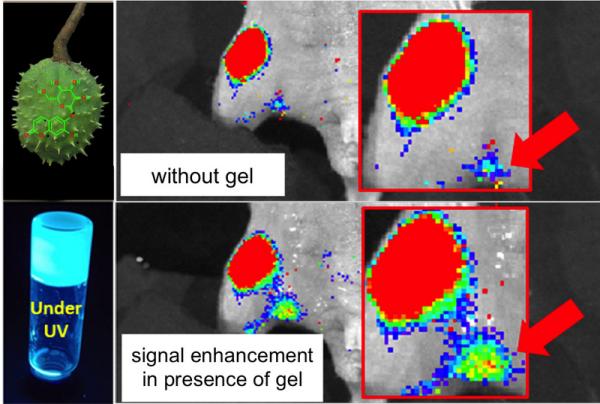
Research at The City College of New York shows that cancer imaging can be simplified by a photonic process utilizing molecules derived from horse chestnuts. The study with potential to better detect the presence of cancer is led by George John, professor in City College’s Division of Science, in collaboration with Jan Grimm, a physician scientist at Sloan Kettering Institute who is also affiliated with Memorial Sloan Kettering Cancer Center and Weill Cornell Medical College.
The team has developed a radiation responsive esculin-derived molecular gel, that is both scintillating and fluorescent, to enhance the optical photon output in image mapping for cancer imaging.
Esculin, or Æsculin, is a coumarin glucoside that naturally occurs in the horse chestnut, a plant extract. It is beneficial to circulatory health.
A challenge currently in cancer imaging is that optical imaging of radiotracers through Cerenkov light (the Grimm lab is one of the leading labs in this field) often produces light that is typically low in intensity and blue-weighted (greatly scattered and absorbed in vivo). It is therefore imperative to increase or shift the photon flux for improved detection.
The gel has been developed to address this challenge.
“Tailoring biobased materials to synthesize thixotropic thermo-reversible hydrogels offers image-aiding systems which are not only functional but also potentially economical, safe, and environmentally friendly,” said John.
“The possibility of developing a topical application from the gel makes this innovation an attractive potential improvement to current techniques of cancer imaging with Cerenkov light,” added Grimm.
A Fellow of Britain’s Royal Society of Chemistry, John’s research is rooted in the idea that innovation can be inspired by nature to develop economical and green technologies for a sustainable future.
Also involved in the research at CCNY’s Center for Discovery and Innovation and scientists from Memorial Sloan Kettering Cancer Center, Weill Cornell Medical College, the Graduate Center, CUNY and Hunter College. The team includes Julian Silverman, Nabendu B. Pramanik, Malick Samateh and Sai Sateesh Sagiri from City College; Travis Shaffer and Qize Zhang from MSKCC.
The study appears in the journal “ACS Appl Mater Interfaces.”
About The City College of New York
Since 1847, The City College of New York has provided low-cost, high-quality education for New Yorkers in a wide variety of disciplines. Today more than 16,000 students pursue undergraduate and graduate degrees in eight professional schools and divisions, driven by significant funded research, creativity and scholarship. Now celebrating its 170th anniversary, CCNY is as diverse, dynamic and visionary as New York City itself. View CCNY Media Kit.